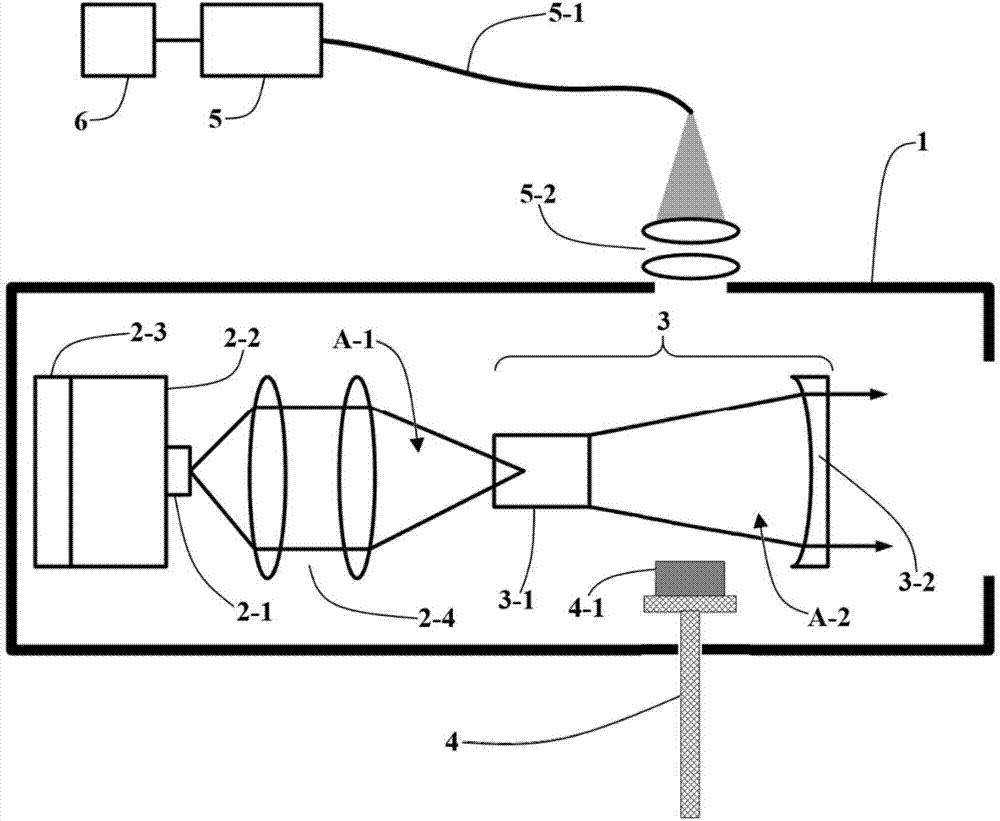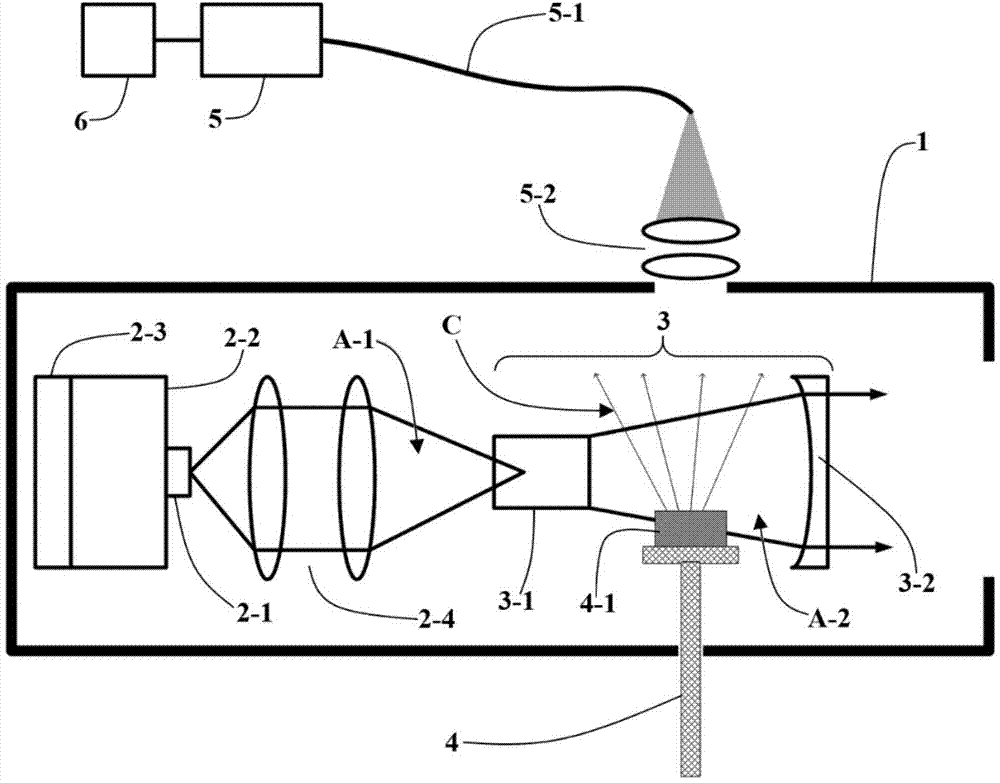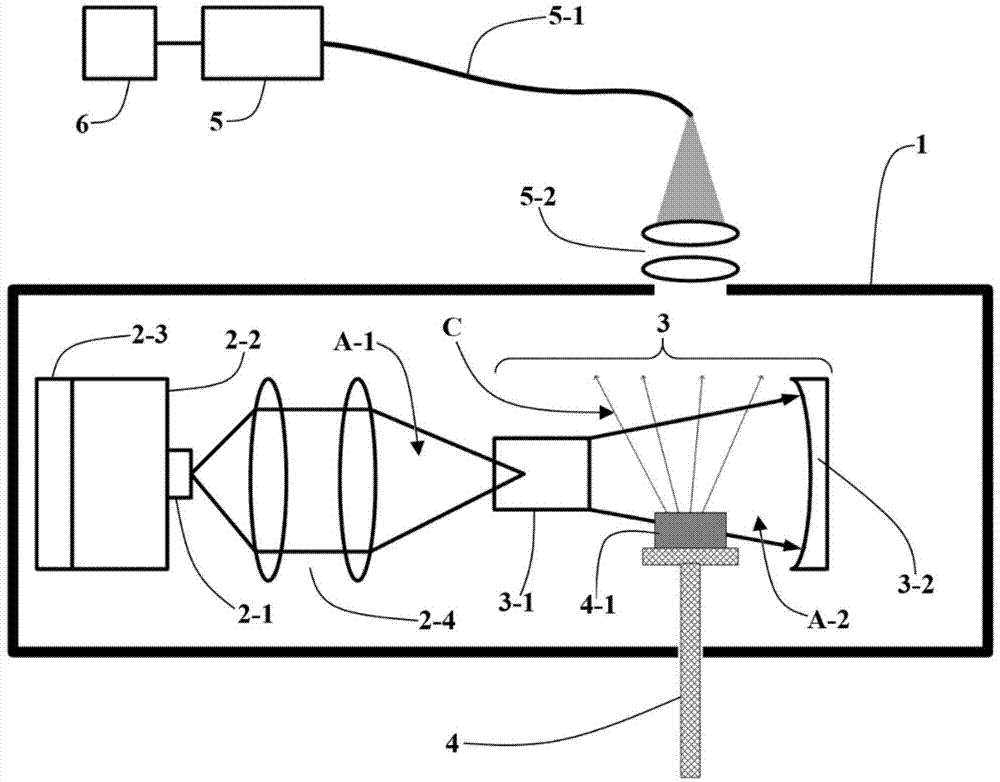Resonant cavity interior laser breakdown spectrum detection device
A laser breakdown spectrum and detection device technology, applied in the field of spectrum measurement, to achieve the effect of easy ionization and high breakdown power
- Summary
- Abstract
- Description
- Claims
- Application Information
AI Technical Summary
Problems solved by technology
Method used
Image
Examples
Embodiment 1
[0030] Such as figure 1 Shown is the basic structure diagram of this embodiment.
[0031] Inside the housing 1 is the structure of a Nd:YAG solid-state laser. A laser diode 2-1 is placed on a radiator 2-2 and a thermoelectric cooler (Thermoelectric Cooler, TE) 2-3. The pumping light A- 1 A group of concentrating devices 2-4 focus on the Nd:YAG crystal rod 3-1; the laser diode 2-1 emits laser light of about 810nm, and the Nd:YAG crystal rod 3-1 is near the end face of the laser diode 2-1 Coated with a film with high transparency to 810nm and high reflection to 1064nm, the rear cavity mirror as the output mirror is a concave mirror 3-2 with a radius of curvature of 5cm, and the concave mirror 3-2 is coated with a For a film with a reflectivity of 95% at 1064nm, the output mirror is a partial reflection mirror at this time; the output mirror and the Nd:YAG crystal rod 3-1 form a resonant cavity 3 . Usually the light intensity in the laser resonator is more than 10 times of the ...
Embodiment 2
[0034] Such as image 3 As shown, the difference between this embodiment and embodiment 1 is that the end of the output mirror near the laser diode 2-1 is coated with a film with a reflectivity of 100% to 1064nm, and the output mirror is a total reflection mirror, so compared to embodiment 1 Said intracavity laser has higher power.
Embodiment 3
[0036] The laser light source of this embodiment uses CO with a wavelength of 10.6um 2 pulsed lasers, such as Figure 4 As shown, the resonant cavity 3 is an F-P cavity formed by a first plane mirror 3-3 and a second plane mirror 3-4 opposite on both sides, and the reflectivity of the opposite face of the two plane mirrors to the 10.6um wavelength incident light B-1 is 99.9%. Change the cavity length by adjusting the distance between the two plane mirrors, when the cavity satisfies the resonance condition u N =(c / 2L)*(N+θ / π), where u N is the interval of the longitudinal mode on the frequency coordinate, c is the speed of light, L is the length of the cavity, N is a natural number, θ is the phase change after the light wave is reflected once, the incident light B-1 resonates in the resonant cavity 3, at this time the cavity The standing wave intensity reaches the maximum, and the light intensity of the oscillating light B-3 is at least 10 times the light intensity of the inp...
PUM
 Login to View More
Login to View More Abstract
Description
Claims
Application Information
 Login to View More
Login to View More - R&D
- Intellectual Property
- Life Sciences
- Materials
- Tech Scout
- Unparalleled Data Quality
- Higher Quality Content
- 60% Fewer Hallucinations
Browse by: Latest US Patents, China's latest patents, Technical Efficacy Thesaurus, Application Domain, Technology Topic, Popular Technical Reports.
© 2025 PatSnap. All rights reserved.Legal|Privacy policy|Modern Slavery Act Transparency Statement|Sitemap|About US| Contact US: help@patsnap.com



